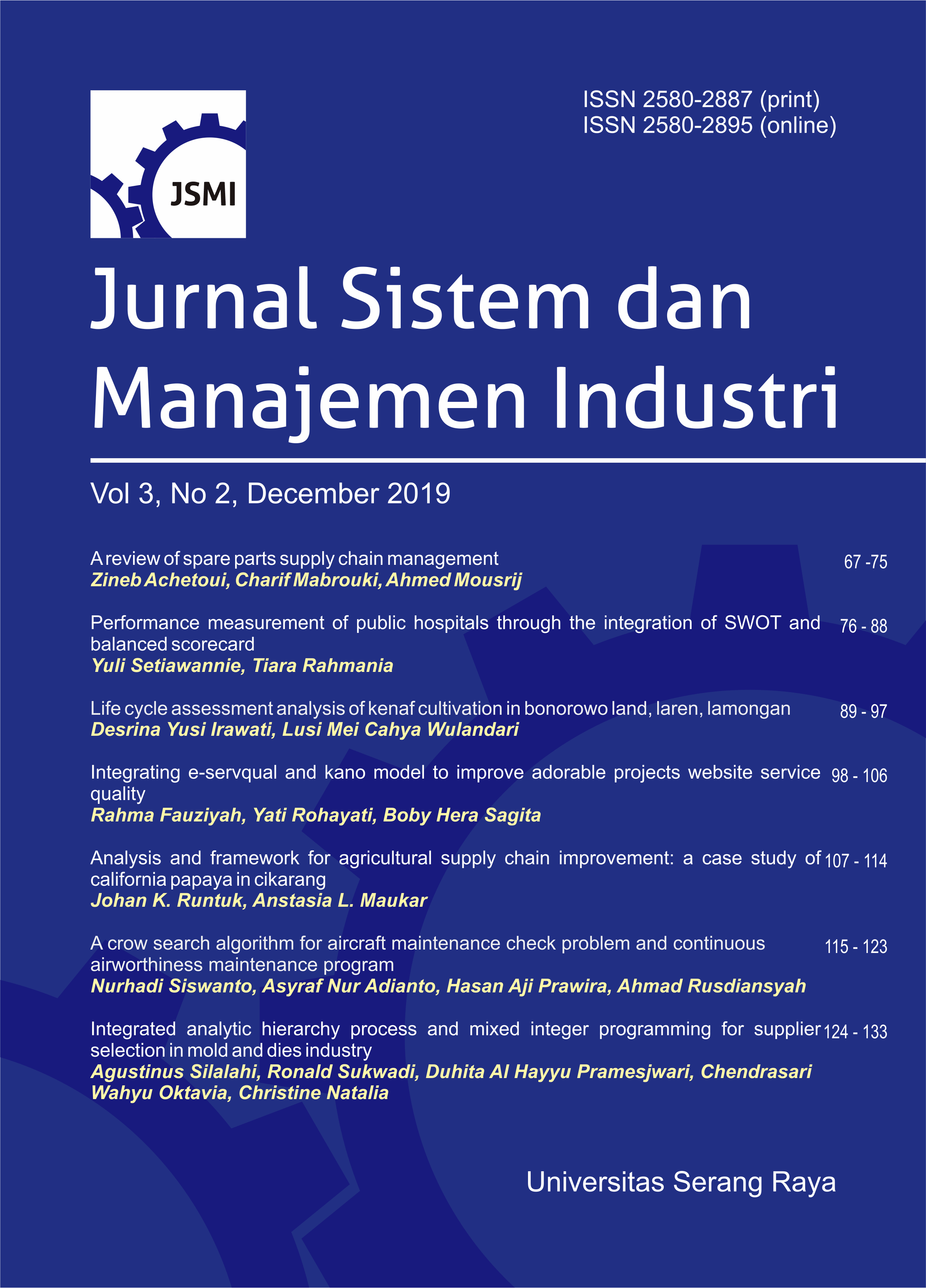Performance measurement of public hospitals through the integration of SWOT and balanced scorecard
DOI:
https://doi.org/10.30656/jsmi.v3i2.1472Keywords:
Balanced Scorecard, Performance Measurement, Hospital Performance, SWOTAbstract
Performance measurement is an essential factor for an organization to control the implementation of the strategy. The existing performance measurement system only evaluates financial performance. This study aims to propose the Key Performance Indicators (KPI) and measuring hospital performance with SWOT and BSC integration. Stages of research are determining internal and external factors with SWOT analysis, formulating alternative strategies, translating strategies into BSC perspective on strategic maps, determining performance indicators (KPI), KPI validation with AHP to obtain indicator weights for each view, and measuring hospital performance. Based on the results of the study, performance indicators (KPI) for hospitals based on the Balanced Scorecard perspective are six financial perspective indicators, two customer perspective indicators, four internal process perspective indicators, and five growth and learning perspective indicators. The internal process perspective is 90.43%, which means that the performance of the hospital is very healthy with the AA category, and learning 68.89% means that the performance of the hospital is very healthy with category A.
Downloads
References
[1] A. R. Taufik, A. Djamhuri, and E. Saraswati, “Performance Measurement Using Balanced Scorecard (BSC) (Study at Hospitals in Pasuruan),†J. Account. Bus. Educ., vol. 3, no. 1, p. 1, Sep. 2018, doi: 10.26675/jabe.v3i1.11553.
[2] Y. D. Nur and S. Haksama, “Pengukuran Kinerja Rawat Inap Berdasarkan Perspektif Balanced Scorecard,†J. Adm. Kesehat. Indones., vol. 4, no. 1, p. 67, Dec. 2016, doi: 10.20473/jaki.v4i1.2016.67-76.
[3] S. E. Kaplan, M. J. Petersen, and J. A. Samuels, “An Examination of the Effect of Positive and Negative Performance on the Relative Weighting of Strategically and Non-Strategically Linked Balanced Scorecard Measures,†Behav. Res. Account., vol. 24, no. 2, pp. 133–151, Nov. 2012, doi: 10.2308/bria-50114.
[4] W. Arisandy, “Strategi Dinas Kesehatan dalam Meningkatkan Kualitas Pelayanan Kesehatan melalui Metode CRC (Citizen Report Card) di Kota Surabaya,†J. Kebijak. dan Manaj. Publik, vol. 3, no. 2, pp. 12–23, 2015, available at: http://journal.unair.ac.id/download-fullpapers-kmp6039f029b9full.pdf.
[5] P. Petera, J. Wagner, and M. MenÅ¡Ãk, “Strategic Performance Measurement Systems Implemented in the Biggest Czech Companies with Focus on Balanced Scorecard - An Empirical Study,†J. Compet., vol. 4, no. 4, pp. 67–85, Dec. 2012, doi : 10.7441/joc.2012.04.05.
[6] Z. Lin, Z. Yu, and L. Zhang, “Performance outcomes of balanced scorecard application in hospital administration in China,†China Econ. Rev., vol. 30, pp. 1–15, Sep. 2014, doi: 10.1016/j.chieco.2014.05.003.
[7] C. W. Chow, D. Ganulin, K. Haddad, and J. Williamson, “The Balanced Scorecard: A Potent Tool for Energizing and Focusing Healthcare Organization Management,†J. Healthc. Manag., vol. 43, no. 3, pp. 263–280, May 1998, doi: 10.1097/00115514-199805000-00010.
[8] A. Abofaied, “Evaluation of Bank’s Performance by Using Balanced Score Card: Practical Study in Libyan Environment,†Int. J. Bus. Manag., vol. 5, no. 1, pp. 1–14, 2017, doi: 10.20472/BM.2017.5.1.001.
[9] Suharno, “Integration of SWOT-Balanced Scorecard to Formulate Strategic Planning in The Technology and Vocational Education in Indonesia,†J. Tech. Educ. Train., vol. 8, no. 2, pp. 62–71, 2016, available at: https://publisher.uthm.edu.my/ojs/index.php/JTET/article/view/1259.
[10] N. Kopecka, “The Balanced Scorecard Implementation, Integrated Approach and the Quality of Its Measurement,†Procedia Econ. Financ., vol. 25, pp. 59–69, 2015, doi: 10.1016/S2212-5671(15)00713-3.
[11] M. A. Salem, N. Hasnan, and N. H. Osman, “Balanced scorecard: Weaknesses, strengths, and its ability as performance management system versus other performance management systems,†J. Environ. Earth Sci., vol. 2, no. 9, pp. 1–9, 2012, available at: https://iiste.org/Journals/index.php/JEES/article/view/3043.
[12] Z. T. Anggraini and E. Nuraina, “Penerapan Balanced Scorecard Sebagai Alat Ukur Kinerja pada Rumah Sakit Umum Dr. Harjono Ponorogo,†Assets J. Akunt. dan Pendidik., vol. 3, no. 2, p. 153, Oct. 2014, doi: 10.25273/jap.v3i2.1220.
[13] N. Ummi and H. Setiawan, “Penerapan Balanced Scorecard Sebagai Dasar SWOT Analisis dalam Perancangan Strategi Pengembangan Divisi PPIC di PT. X,†in Seminar Nasional Teknik Industri Universitas Gajah Mada, 2015, pp. E92–E102, available at: http://digilib.mercubuana.ac.id/manager/t!@file_artikel_abstrak/Isi_Artikel_396277236994.pdf.
[14] A. Afonina, “Strategic Management Tools and Techniques and Organizational Performance: Findings from the Czech Republic,†J. Compet., vol. 7, no. 3, pp. 19–36, Sep. 2015, doi: 10.7441/joc.2015.03.02.
[15] R. E. Sari and A. Saleh, “Penilaian kinerja dosen dengan menggunakan metode AHP (Studi kasus: di STMIK Potensi Utama Medan),†in Seminar Nasional Informatika (SNif), 2014, vol. 1, no. 1, pp. 108–114, available at: http://e-journal.potensi-utama.ac.id/ojs/index.php/SNIf/article/view/230.
[16] T. Yaghoobi and F. Haddadi, “Organizational performance measurement by a framework integrating BSC and AHP,†Int. J. Product. Perform. Manag., vol. 65, no. 7, pp. 959–976, Sep. 2016, doi: 10.1108/IJPPM-01-2015-0001.
[17] R. E. Sari, A. Meizar, D. H. Tanjung, and A. Y. Nugroho, “Decision making with AHP for selection of employee,†in 2017 5th International Conference on Cyber and IT Service Management (CITSM), 2017, pp. 1–5, doi: 10.1109/CITSM.2017.8089285.
[18] N. Khalil, S. N. Kamaruzzaman, and M. R. Baharum, “Ranking the indicators of building performance and the users’ risk via Analytical Hierarchy Process (AHP): Case of Malaysia,†Ecol. Indic., vol. 71, pp. 567–576, Dec. 2016, doi: 10.1016/j.ecolind.2016.07.032.
[19] S. Rochmani, A. Fudholi, and L. Hakim, “Analisis Faktor Internal-Eksternal Terhadap Pengelolaan Obat Di Instalasi Farmasi RSUD DR. Moewardi Surakarta,†JPSCR J. Pharm. Sci. Clin. Res., vol. 1, no. 1, pp. 10–20, 2016, available at: https://jurnal.uns.ac.id/jpscr/article/view/684.
[20] D. Novanda and D. Novanda, “Implementasi integrasi swot balanced scorecard dalam perancangan sistem pengukuran kinerja PT grafika jaya sumbar,†Thesis, Universitas Andalas, 2014, available at: http://repo.unand.ac.id/3119/.
[21] I. Budiman, U. P. P. Tarigan, A. Mardhatillah, A. C. Sembiring, and W. Teddy, “Developing business strategies using SWOT analysis in a color crackers industry,†J. Phys. Conf. Ser., vol. 1007, no. 1, p. 012023, Apr. 2018, doi: 10.1088/1742-6596/1007/1/012023.
[22] W. Wiyanto, E. Soekarjono, and B. Hasmanto, “Strategi Bersaing Dalam Rangka Menghadapi MEA (Studi Kasus Rs. Bhakti Asih Karang Tengah -Tangerang),†J. Pemasar. Kompetitif, vol. 1, no. 3, pp. 93–111, Mar. 2018, doi: 10.32493/jpkpk.v1i3.1146.
[23] E. Hanafi and Z. Fatma, “The Effect of The Integration Between Levers of Control and SWOT Analysis on Organizational Performance: Balanced Scorecard Approach,†Int. J. Acad. Res., vol. 7, no. 1, pp. 215–221, 2015, available at: http://scholar.cu.edu.eg/sites/default/files/fzaki/files/201533b-37.pdf.
[24] H. Rahimi, J. Bahmaei, P. Shojaei, Z. Kavosi, and M. Khavasi, “Developing a Strategy Map to Improve Public Hospitals Performance with Balanced Scorecard and DEMATEL Approach,†Shiraz E-Medical J., vol. 19, no. 7, p. e64056, Jun. 2018, doi: 10.5812/semj.64056.
[25] D. A. A. Malgwi and H. Dahiru, “Balanced Scorecard financial measurement of organizational performance: A review,†IOSR J. Econ. Financ., vol. 4, no. 6, pp. 01–10, 2014, doi: 10.9790/5933-0460110.
[26] H. Rahimi, Z. Kavosi, P. Shojaei, and E. Kharazmi, “Key performance indicators in hospital based on balanced scorecard model,†J. Heal. Manag. Informatics, vol. 4, no. 1, pp. 17–24, 2017, available at: http://jhmi.sums.ac.ir/article_42683.html.
[27] I. Gabcanova, “Human Resources Key Performance Indicators,†J. Compet., vol. 4, no. 1, pp. 117–128, Mar. 2012, doi: 10.7441/joc.2012.01.09.
[28] M. Khalifa and P. Khalid, “Developing Strategic Health Care Key Performance Indicators: A Case Study on a Tertiary Care Hospital,†Procedia Comput. Sci., vol. 63, pp. 459–466, 2015, doi: 10.1016/j.procs.2015.08.368.
[29] V. Capkun, M. Messner, and C. Rissbacher, “Service specialization and operational performance in hospitals,†Int. J. Oper. Prod. Manag., vol. 32, no. 4, pp. 468–495, Mar. 2012, doi: 10.1108/01443571211223103.
[30] C. McDermott and G. N. Stock, “Hospital operations and length of stay performance,†Int. J. Oper. Prod. Manag., vol. 27, no. 9, pp. 1020–1042, Aug. 2007, doi: 10.1108/01443570710775847.
[31] A. Anuar, R. Saad, and R. Z. Yusoff, “Operational Performance and Lean Healthcare in the Healthcare Sector: Review on the Dimensions and Relationships,†Int. J. Acad. Res. Bus. Soc. Sci., vol. 8, no. 4, pp. 276–292, 2018, available at: https://ideas.repec.org/a/hur/ijarbs/v8y2018i4p276-292.html.
[32] D. Podgórski, “Measuring operational performance of OSH management system – A demonstration of AHP-based selection of leading key performance indicators,†Saf. Sci., vol. 73, pp. 146–166, Mar. 2015, doi: 10.1016/j.ssci.2014.11.018.
[33] I. Kesuma, “Analisis Penilaian Kinerja Rumah Sakit Dengan Penerapan Balanced Scorecard (Studi Kasus Rumah ‘ABC’),†J. Sist. Inf., vol. 3, no. 1, pp. 1–7, 2014, available at: http://repository.unsri.ac.id/9358/.
[34] R. Freddy, SWOT Balanced Scorecard (Teknik Menyusun Strategi Korporat yang Efektif plus Cara Mengeola Kinerja dan Risiko). Jakarta: Gramedia Pustaka Utama, 2011. available at: Google Scholar.
Downloads
Published
Issue
Section
License
All articles in Jurnal Sistem dan Manajemen Industri can be disseminated provided they include the identity of the article and the source of the article Jurnal Sistem dan Manajemen Industri. The publisher is not responsible for the contents of the article. The content of the article is the sole responsibility of the author
Jurnal Sistem dan Manajemen Industri is licensed under a Creative Commons Attribution-NonCommercial-ShareAlike 4.0 International License.
















1.png)
.png)
.png)
.png)


